A wealth of Unreal Engine 5 games are finally here - so how are the consoles coping?
Presentation and performance trends from PS5, Series X and Series S.
After years of waiting, Unreal Engine 5 is finally here with a decent roster of full games to look at, beyond the tech demos and samples we had in the past. The early results have been mixed, with some titles exhibiting UE5's merits convincingly while others have been bogged down by image quality or performance problems. Yet there's one question that hasn't been answered quite as well: how well do these technologies scale to console systems? Today we're looking at the current state of Unreal Engine 5 on PS5, Series X and Series S to evaluate how the technology fares in early game efforts.
The key takeaway from my experiences with Unreal Engine 5 so far is that the core feature set works. Lumen global illumination (GI) solves indirect lighting in real time to a high degree of fidelity, producing great-looking shading in most circumstances when set up correctly. Lumen reflections similarly help to light glossy and semi-gloss surfaces correctly, giving them good-looking reflective detail. Virtual shadowmaps overcome the limitations of cascaded shadowmap techniques to deliver super-fine shadow detail, with accurate variable penumbra in some cases. Meanwhile, Nanite delivers high-quality meshes with a continuous level of detail system that simplifies asset production and prevents LOD popping.
In the few games where these techniques are combined effectively, we do see a pretty tremendous uplift in visual quality relative to games on Unreal Engine 4. The lighting detail in UE5 titles is superb, even in games that are only making use of the software UE5 rendering mode, which isn't using hardware ray tracing. You get lots of fine indirect lighting, reflections, and shadows, with each technique showing fidelity that wouldn't really be replicable in a last-generation game. In broad strokes, the tech works. But when we do an in-depth look at some of the console versions of these games, the results can be a bit more mixed at times. We're going to look at PS5 and Series X first, before moving onto Series S later.
Fort Solis is a good example. The game's Lumen GI is doing some really cool stuff here, with areas that are flooded with subtle illumination when lights turn on and real-time bounce lighting from the player flashlight. But there are other instances, where we get a lot of breakup and artefacting in the Lumen GI, which is in its software guise here. I think this shows the importance of getting these techniques implemented well, which could involve changing lighting arrangements, removing emissive lights, or adding more direct lighting to the scene.
You could also simply increase the amount of rays shot into the scene per pixel. We can see the flipside of this problem when we put the game into performance mode, where the breakup and shimmer becomes a much greater problem. Increasing the ray count - or shifting the game into the more expensive hardware RT implementation of Lumen - could be beyond the capabilities of the console though, depending on the game. The PC version of Fort Solis certainly looks much better when modified to support hardware ray tracing, but that might have proven too expensive on PS5.
The Talos Principle is another recent UE5 title that shows off some of the potential issues with UE5 on consoles. There's some stuff that's pretty cool here - like super-fine shadow detail courtesy of UE5's virtual shadowmap system. The Nanite geometry is also very dense, and doesn't present with any LOD pop-in. Lumen reflections seem to have been omitted though, perhaps as a consequence of targeting consoles, though these reflections can be enabled on PC.
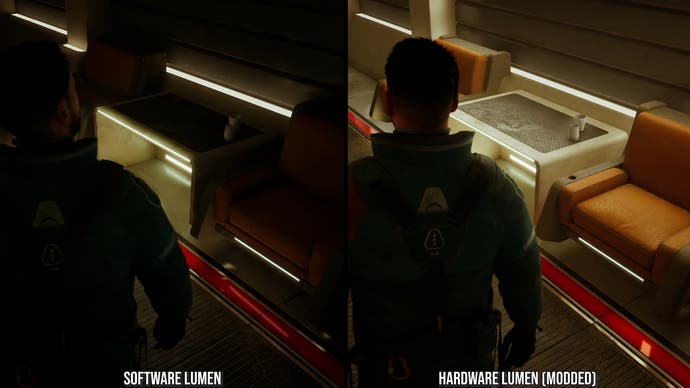
Probably the biggest issues are related to the Lumen GI, once again. The GI treatment can look pretty terrific here, with a beautiful representation of indirect illumination that is a real standout. But there are problems, like how foliage is badly over-darkened and lighting suffers from obvious breakup in some moments as well, with a spotty appearance. In the absence of more powerful console hardware, you will see some of these lighting issues in indirectly lit areas across titles that use Lumen.
Immortals of Aveum presents certain Lumen lighting issues as well, mostly related to that over-darkening issue with software Lumen. The coarseness of the signed distance fields (SDFs) gives us some very shade on the roots here, which we wouldn't see in real life, though with less fine geometry the results are excellent. When we fire our spells at a wall, you can see a crude, speckled impression of the light on the ceiling. The results here are mostly decent, but indirectly-illuminated scenes do expose some issues.
With these games I think we see some of the practical limits of UE5 techniques on consoles. Their power constraints necessitate certain compromises for performance, which PC hardware is sometimes able to overcome when given access to higher settings options.
I think Robocop is probably the best-adjusted of the recent UE5 crop on consoles. The lighting just looks superb here, and any Lumen issues are kept to a minimum - generally, you have to go out of your way to find them. The game also looks great in its 60fps mode, even with a visibly lower ray count for Lumen GI, and we get solid Lumen reflections here too. There are ways to get really great results out of these techniques even if you don't have a lot of hardware power on tap, though it does seem to require some careful artist work.
Jusant is a fascinating and well-designed recent UE5 game that's worth highlighting as well. The game uses very low-detail textures, so a lot of the colour variation in the image comes from indirect lighting. Light bounces through spaces and pools in crevices, with some terrific-looking imagery as a result. Software Lumen's exaggerations work pretty well in this context I think, given the more stylised art. Virtual shadowmaps are highlighted effectively here as well, lending pin-sharp and highly detailed shadows to even the most minor geometric elements.
For a quick look at what the hardware RT path for UE5 may look like on consoles, we need to take a trip back to 2021's The Matrix Awakens demo. The Lumen indirect lighting detail looks great here, and mostly resolves without visible noise. Reflections are the real standout here though, as tracing against triangles allows them to closely approximate the scene in a way that can't really be replicated with software Lumen.
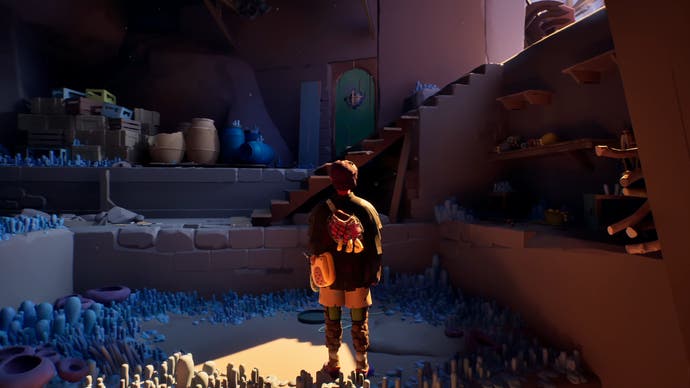
Visual quality is only half the story here though, so what about performance? With the 30fps games using UE5, frame-rates tend to be quite consistent. Robocop does throw up some drops in very intense action, but otherwise there aren't really any issues. At 60fps, there's a bit of a spectrum: Jusant is nearly perfect, with very occasional one-off drops that look like traversal stutters, while Immortals of Aveum is usually sub-60 and Lords of the Fallen suffers from profound stuttering issues.
It's not totally clear what to chalk up to UE5 though. For instance, Immortals of Aveum actually runs a lot better on Series S than Series X, albeit at a much lower resolution, suggesting that the issues are primarily GPU-related. Just setting the game to a lower resolution would likely clean up most of the issues that we're seeing here. The same is likely true for Robocop, which drops down pretty hard during some more intense battles but exhibits decent CPU performance on PC. I would much prefer the developers of these games set a more conservative resolution target, instead of presenting a variable performance level.
Other issues, like the traversal stutters we see in many UE5 games, seem more closely linked to the engine technology. These may be harder to overcome, but achieving a generally good performance level on consoles using UE5 seems entirely possible, judging from the results in these early titles.
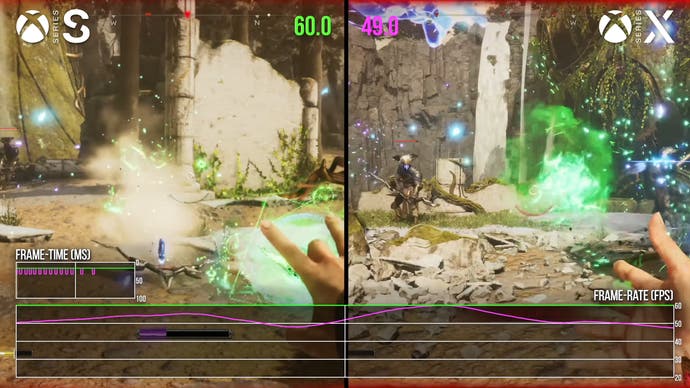
The other side of the console question is how well games scale to Series S. I've been showcasing Series X and PS5 so far because these consoles offer the canonical current-gen experience, but UE5 games do need to scale to Microsoft's 4TF cut-price console as well, with all the difficulties that entails. It's far weaker in GPU power than any other current-gen console, and has a cut-back memory arrangement as well.
We see a few approaches to targeting Series S here. One option is to simply omit certain features that won't run well. The Talos Principle 2 excises Lumen GI on Series S, for instance, which dramatically degrades the game's lighting presentation. We don't get the beautiful occlusion and dramatic bounce that we see on Series X. The developers of The Talos Principle 2 have actually built a non-Lumen lighting pipeline for Series S and lower-end PCs, using simple fill lights to mimic global illumination, along with ambient occlusion, but the results are far from the Lumen-driven presentation on higher-end systems. That also means that there's no Lumen GI fallback for reflections on Series S when the SSR is occluded.
We see a similar approach in Robocop, where Lumen reflections are cut on Series S. The SDF-based reflections here are absent on the Series S, which creates some issues with occlusion, and produces a less accurate material response on glossy and semi-gloss surfaces. Fortunately, the Lumen GI is retained here on the S, which is definitely the more important of the two techniques in this game, although it has to make do with fewer rays. Epic's Fortnite takes a similar tack, removing Lumen reflections from Series S, and limiting virtual shadowmap coverage as well.
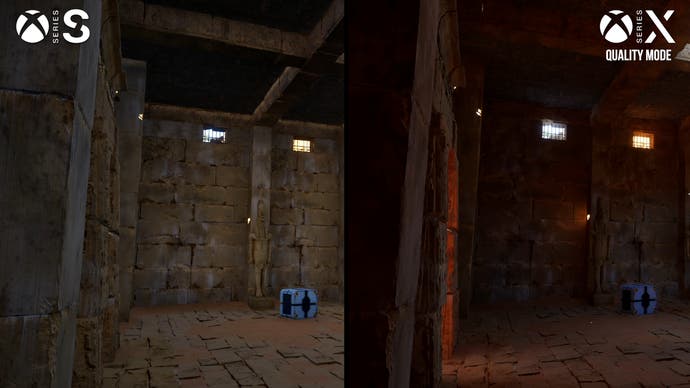
The other approach is to retain those major UE5 visual features on Series S and just degrade their appearance as necessary to keep performance in check. Jusant takes this path, lowering the resolution of virtual shadowmaps somewhat, with more visible stairstepping, and slightly decreasing the fidelity of the Lumen GI. The Matrix Awakens is another good example; it definitely has a lot of nips and tucks on Series S if you look side-by-side, but you do retain all the key UE5 features, just with an obvious decrease in fidelity and running at a much lower rendering resolution. This may prove the more difficult approach, especially if RAM constraints are a factor.
So far, I think UE5 games have actually scaled reasonably well to the Series S. There are obvious cuts, but I think the system, for the most part, preserves the essential visual character of the higher-end console versions of these games. The only exception in the games I've tested would be The Talos Principle 2, which looks almost generationally different at times because of the degraded lighting setup on Series S. I think retaining Lumen GI is going to be critical for most games.
Performance wise, the results are mostly similar to the higher-end consoles. Jusant runs about the same as its Series X counterpart, while The Talos Principle runs slightly worse. Immortals of Aveum actually runs a lot better, with a pretty solid 60fps update, though this comes with a very low resolution as a trade-off. Robocop only has a 30fps mode on Series S, and it does suffer from more frequent FPS dips, though it retains a reasonable resolution. I'm not seeing huge cause for concern on the performance front on Series S, though in terms of visual features the outcomes are more mixed.

Upsampling is critical to maintaining good performance in UE5. The engine's key features scale directly with rendering resolution, so high base resolutions are going to be out of the question for a lot of UE5 efforts. To compensate on consoles, most developers are going to use one of two upsampling techniques: FidelityFX Super Resolution 2, or Temporal Super Resolution, which are both supported in UE5 for console use.
Robocop's PC build supports both techniques, making it a good testbed to see which would work well on console. With a fairly demanding 720p to 1440p upscale, both techniques do an okay job in stills - though you can note some additional breakup with FSR 2 in a few places in the image. But when actually moving through the game world, there's a pretty stark difference in favour of the TSR technique here. Neither is producing an entire anti-aliased image mind you, but the TSR is a lot cleaner in typical play.
This difference is magnified when we do a simple horizontal pan without any motion blur. FSR 2 has a super-aliased, highly noisy image under this kind of camera movement, while TSR keeps shimmer pretty much under control, without obtrusive artefacting. I also noticed that the TSR tends to have fewer ghosting artefacts in this game.
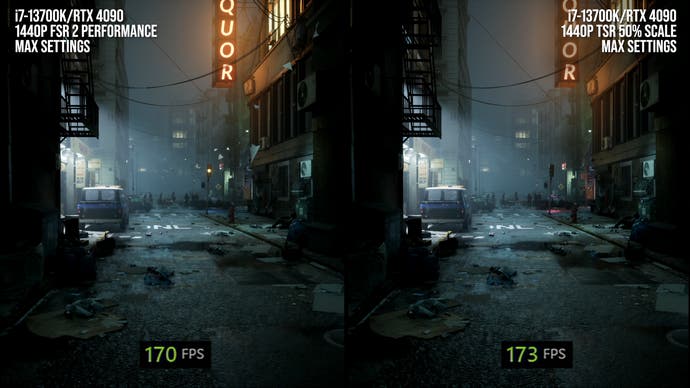
In terms of performance, TSR also slightly outperforms FSR 2 here, clocking in with a small advantage at 1440p output in performance mode and at 4K in quality mode. These techniques can vary in quality a bit from title to title, so this shouldn't be taken as a dispositive verdict on the relative merits of the two techniques, but it certainly seems like TSR may be the better choice on consoles. Even with a pretty heavy upscale factor here, it's producing a perfectly good-looking final image - one that would hold up decently from a typical viewing distance on a 4K display.
Ultimately, I think we are seeing some mostly positive indications from UE5 in console games. The core graphical tech clearly scales well to console hardware, delivering some really impressive visual results in problem areas for real-time rendering. A game like Robocop is delivering top-tier console visuals with the help of UE5, for instance. On the performance front, some games do struggle, though in some cases this seems to be more at the hands of the developer than the UE5 tools.
Performance in future games will prove more interesting. This early crop of titles mostly consists of lower-budget fare and we haven't seen a lot of big-budget AAA efforts to really stress the engine tech. Can a game that features super-detailed Nanite meshes and intricate character models hit a solid frame-rate on consoles, especially when aiming for 60fps? Will big-budget games sidestep or overcome the traversal stutter issues often associated with Unreal? And can they achieve good-looking visuals on Series S while retaining key UE5 tech? I don't think we have good answers to these questions, but they should be forthcoming over the next year or two.



.png?width=291&height=164&fit=crop&quality=80&format=jpg&auto=webp)






